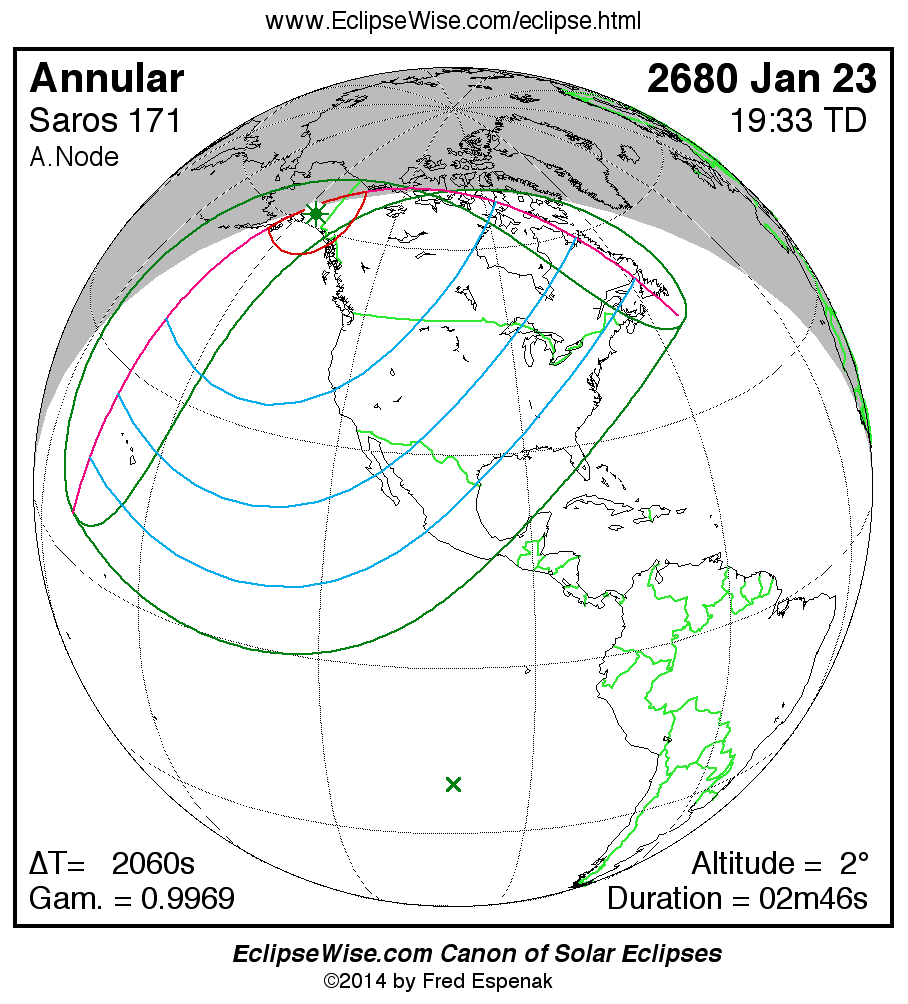Solar Eclipse Prime Page
Annular Solar Eclipse of 2680 Jan 23
Fred Espenak
Introduction
The Annular Solar Eclipse of 2680 Jan 23 is visible from the geographic regions shown on the map to the right. Click on the map to enlarge it. For an explanation of the features appearing in the map, see Key to Solar Eclipse Maps.
The instant of greatest eclipse takes place on 2680 Jan 23 at 19:32:54 TD (18:58:34 UT1). This is 5.9 days before the Moon reaches perigee. During the eclipse, the Sun is in the constellation Sagittarius. The synodic month in which the eclipse takes place has a Brown Lunation Number of 9364.
The eclipse belongs to Saros 171 and is number 17 of 69 eclipses in the series. All eclipses in this series occur at the Moon’s ascending node. The Moon moves southward with respect to the node with each succeeding eclipse in the series and gamma decreases.
This annular eclipse is unsual in that it does NOT have a northern path limit. Instead, one edge of the antumbral shadow falls off into space throughout the eclipse. Gamma has a value of 0.9969.
The annular solar eclipse of 2680 Jan 23 is preceded two weeks earlier by a partial lunar eclipse on 2680 Jan 08.
These eclipses all take place during a single eclipse season.
The eclipse predictions are given in both Terrestrial Dynamical Time (TD) and Universal Time (UT1). The parameter ΔT is used to convert between these two times (i.e., UT1 = TD - ΔT). ΔT has a value of 2060.1 seconds for this eclipse. The uncertainty in ΔT is 490.0 seconds corresponding to a standard error in longitude of the eclipse path of ± 2.05°.
The following links provide maps and data for the eclipse.
- Orthographic Map: Annular Solar Eclipse of 2680 Jan 23 - global map of eclipse visibility
- Google Map: Annular Solar Eclipse of 2680 Jan 23 - interactive map of the eclipse path
- Path Table: Annular Solar Eclipse of 2680 Jan 23 - coordinates of the central line and path limits
- Circumstances Table: Annular Solar Eclipse of 2680 Jan 23 - eclipse times for hundreds of cities
- Saros 171 Table - data for all eclipses in the Saros series
The tables below contain detailed predictions and additional information on the Annular Solar Eclipse of 2680 Jan 23 .

